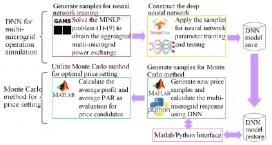New Analytic Approach Advances Multi-microgrid Energy Management for Performance and Profit
Microgrids—decentralized sources of electricity that can operate while a main grid is down—have significant capability to provide energy and ancillary services to the electric utility grid in both normal and urgent conditions. Researchers at the University of Tennessee-Knoxville (UTK) have developed and demonstrated methods for analyzing real-time operation of multiple networked microgrids, enhancing their ability to contribute greater efficiency, higher reliability, lower cost, and better accommodation of renewable sources in future power generation. These efforts were undertaken by the Center for Ultra-Wide-Area Resilient Electric Energy Transmission Networks (CURENT), a National Science Foundation (NSF) Engineering Research Center (ERC) supported by NSF and the U.S. Department of Energy and headquartered at UTK.
This work provides a new data-driven energy management approach for multiple networked microgrids and demonstrated its potential in real-time operation of future microgrids. Wide-area coordinated control of the transmission grid is CURENT’s vision. A microgrid is a decentralized group of electricity sources and loads that normally operates connected to and synchronous with the traditional wide area synchronous grid but is also able to disconnect and function autonomously as technical or economic conditions dictate, with little or no ramp-up needed. CURENT’s UTK researchers were able to apply their novel modeling and estimation approaches to analyze, enhance, and advance wide-area control of power systems.
There are two types of reinforcement learning methods: model-based and model-free. The model-based method employs a set of assumptions and perspectives. The model-free algorithm can be described as based more on trial and error. The CURENT researchers used an intelligent multi-microgrid energy management method based on deep neural network and model-free techniques to study the trade-off made by distribution system operators to decrease the demand-side peak-to-average ratio (PAR), and to maximize the profit from selling energy.
In CURENT’S UTK study scenario, multiple microgrids were connected to a main distribution system and purchased power from the distribution system to maintain local consumption. The results of their simulations, as well as comparisons with conventional model-based methods, substantiated the effectiveness of the proposed approach in solving power system problems with partial or uncertain information.




